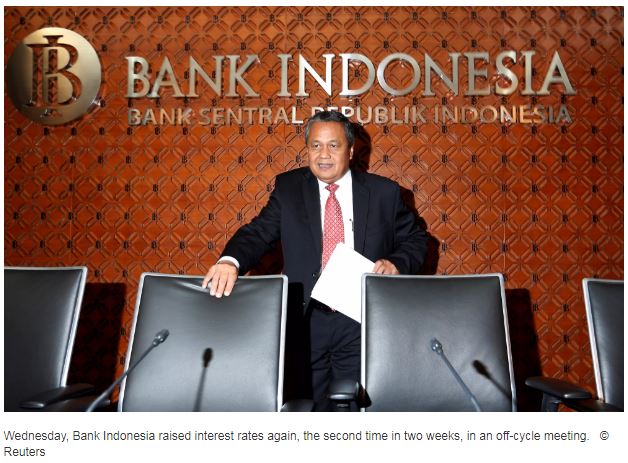Risks expand for debt-heavy Southeast Asian markets
SINGAPORE (Nikkei Markets) — The pressure on emerging markets in Southeast Asia is set to increase as the strengthening dollar aggravates concerns about debt in the region.
The recent political turmoil in Italy has added to the risks that have weighed on these markets in recent months, weakening both their currencies and stocks.
Among the most vulnerable are the Philippines and Indonesia, which have the highest proportions of foreign debt in the group, and, to a lesser extent, Malaysia, where a sudden change in government has given foreign funds another reason to exit their investments in the country.
Although the central banks in Manila and Jakarta have already resorted to interest rate hikes to support their currencies, views are divided on the efficacy of such measures given the buildup of negative factors.
Song Seng Wun, an economist at CIMB Private Banking, said that the markets were rotating concerns, including the state of the U.S. economy and the likelihood that the U.S. Federal Reserve could become more aggressive in hiking interest rates.
The latest bout of risk aversion was prompted by the failure of populist Italian parties to form a government. Investors, spooked by the prospect of snap elections that could become a referendum on whether the country would remain in the eurozone, sold down European assets while the dollar gained.
There are signs that Italy may yet avert a crisis with calls for a compromise solution.
However, the lingering political risk, coming on top of trade-related friction between the U.S. and China and higher oil prices, could quicken the flight of funds to safer assets, especially those in the U.S. where the economy is growing at a reasonable pace and interest rates are trending up.
That’s likely to support the dollar’s strength, analysts say.
High foreign investment participation, especially in the Indonesian and Malaysian markets, could amplify the effects of general emerging market risk aversion, Moody’s Investors Service said in a note last week.
Both countries have also made it to Nomura’s list of the top 10 emerging market countries most exposed to contagion risk from Italy based on the size of their exports to the country and to the European Union.
Foreigners held 39.3% of government bonds in Indonesia as of March, down from 39.8% in December, among the highest percentages in emerging Southeast Asia. In Malaysia, the proportion was at 27.4% in the first quarter of 2018, according to central bank data, down from 27.7% in the fourth quarter of 2017.
According to a Maybank Kim Eng report citing Bloomberg data, Indonesia and Malaysia have seen the largest foreign outflows from their bonds this year.
As for stocks, foreign investors in Malaysia have sold about $847 million worth of shares since the May 9 elections to the end of last week, although local funds have stepped in to buy, cushioning the market’s fall.
So far, only Thailand has shown some resilience in the group. That’s primarily due to its dependence on the energy sector and oil prices as well as its current account surplus, which exceeds 10% of gross domestic product.
In Indonesia, the rupiah has lost almost 3% against the dollar this year after receiving some support from recent interest rate hikes. Wednesday, Bank Indonesia raised rates again, the second time in two weeks, in an off-cycle meeting.
Meanwhile, Jakarta stocks have fallen around 6.1%.
In the Philippines, infrastructure-related imports and weaker remittance inflows have pushed up the country’s current account deficit. The peso, which hit a 12-year low against the dollar late last week, has fallen 5% against the dollar since the start of the year.
According to Nomura, a weaker peso has historically coincided with weaker corporate earnings growth. That could extend the pressure on stocks. The Philippines’ PSEi Index has dropped around 12.4% year-to-date, the worst performing of the emerging markets in Southeast Asia.
Some observers have compared the current turn in markets to the taper tantrum, which began in 2013 after then U.S. Fed chief Ben Bernanke first broached the idea of scaling back the quantitative easing program of buying bonds, roiling emerging economies.
However, analysts don’t expect upheaval of the same magnitude this time as most Southeast Asian markets have shored up their finances and reserves.
Still, depreciating currencies could pose problems for countries with a large amount of foreign debt.
Indonesia’s foreign currency debt stands at 40% of its total debt at the end of last year, while that of the Philippines is at 37%. Both are above the Asia-Pacific median of around 30%, Moody’s said.
According to Moody’s, both countries have weak debt-affordability metrics, which is a measurement of interest payments against revenue or gross domestic product. Moody’s said continued currency depreciation and rising interest rates would worsen debt affordability even further.
–Leslie Shaffer
Source: https://asia.nikkei.com/Business/Markets/Nikkei-Markets/Risks-expand-for-debt-heavy-Southeast-Asian-markets


 English
English




